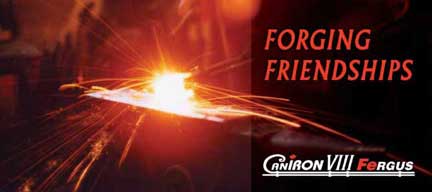|
|
Jesus HernandezHuntsville, Alabama
www.jhbladesmith.com

" I am a bladesmith. For a long time I have been fascinated with the ability to create both useful and beautiful objects by hand. The craft of a blade represents an expression of that ability. From understanding how metal moves under the hammer to shaping a piece of raw wood into a handle, every aspect of this art is capable of bringing a sense of satisfaction to the maker and to the owner of such creations. " " I started making blades because of my interest in Japanese swords. I have practised and taught different forms of kenjutsu over the years. I regularly refine my skills at tameshigiri ┼\cutting tatami or bamboo targets┼\ and I am a modest collector of Japanese swords. I have been a student of nihonto for many years. " " Driven by a thirst for knowledge, I took the challenge of learning how the Japanese swords were made and what made them so special. Hence, I started a long road into bladesmithing. "  Ayasugi dagger" This dagger is part of the first international exhibition of contemporary bladesmiths held at the Macau Museum of Art. " This is a special project made of 1050, 1095 and 15N20 steel. Folded to about 100 layers and then manipulated to generate a pattern that will imitate the AYASUGI hada of the GASSAN school of Japanese swordsmiths of which I have been particularly fond. Cable damascus guard and pommel and stabilized California buckeye burl handle. The blade is 9 1/2 inches and the overall length is 14 inches." Bamboo tanto" Aikuchi style tanto made of tamahagane steel. Nagasa 7.5 inches. Overall length 13.5 inches. The hada is simply beautiful resembling a raging fire with lighting strikes in the hamon. There is utsuri. The fittings are delicately brought to a great finish to compliment the blade. Multiple materials are used for the koshira: a carved copper habaki, buffalo horn for the koiguchi, fuchi and kashira. Mokume gane menuki. Horn pin and high quality same for the wrap. The kojiri is reinforced with cured bamboo. Lacquered saya with gold paint of bamboo design. The red kanji letters read: 'Shadow of the Wind.' "  Tiger tanto" This blade's steel was made in a tatara at the first hammer-in organized by Kerry and Matt Stagmer at their shop in Maryland. The following year a portion of the steel was consolidated, folded and turned into this tanto. The saya is made of curly maple and the spacers are snake wood. The habaki is copper. "Iron Smelting - Japanese Tatara and Southern European Catalan Furnaces
|


